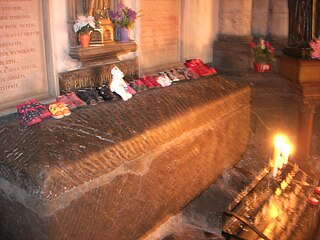Related Research Articles
Aimoin of Fleury, French chronicler, was born at Villefranche-de-Longchat, Southwestern France about 960. Early in his life he entered the monastery of Fleury, where he became a monk and then passed the greater part of his life. Between c. 980 and 985 Aimoin wrote about St. Benedict in Abbey of Fleury-sur-Loire. His chief work is a Historia Francorum, or Libri V. de Gestis Francorum, which deals with the history of the Franks from the earliest times to 653, and was continued by other writers until the middle of the twelfth century. It was much in vogue during the Middle Ages, but its historical value is now regarded as slight. It was edited by G. Waitz and published in the Monumenta Germaniae Historica: Scriptores, Band xxvi.

Eadmer or Edmer was an English historian, theologian, and ecclesiastic. He is known for being a contemporary biographer of his archbishop and companion, Saint Anselm, in his Vita Anselmi, and for his Historia novorum in Anglia, which presents the public face of Anselm. Eadmer's history is written to support the primacy of Canterbury over York, a central concern for Anselm.
Ado of Vienne was archbishop of Vienne in Lotharingia from 850 until his death and is venerated as a saint. He belonged to a prominent Frankish family and spent much of his early adulthood in Italy. Several of his letters are extant and reveal their writer as an energetic man of wide sympathies and considerable influence. Ado's principal works are a martyrology, and a chronicle, Chronicon sive Breviarium chronicorum de sex mundi aetatibus de Adamo usque ad annum 869.
Saint Grimbald was a 9th-century Benedictine monk at the Abbey of Saint Bertin near Saint-Omer, France.
Faritius was an Italian Benedictine Abbot of Abingdon and physician.
Herigerus was a Benedictine monk, often known as Heriger of Lobbes for serving as abbot of the abbey of Lobbes between 990 and 1007. Remembered for his writings as theologian and historian, Herigerus was a teacher to numerous scholars. His biography describes him as "skilled in the art of music", though no music theory treatise survives and neither do the two antiphons and one hymn attributed to him.
Osbern of Canterbury or Monk Osbern was a Benedictine monk, hagiographer and musician, precentor of Christ Church, Canterbury.

Dom Thierry Ruinart (1657–1709) was a French Benedictine monk and scholar. He was a Maurist, and a disciple of Jean Mabillon. Of his many works, the one now cited is his Acta sincera, a martyrology, written in Latin. His work is one of the main sources of Alphonsus Liguori's "Victories of the Martyrs". He was also interested in oenology. In 1729 his nephew Nicolas Ruinart founded the champagne house of Ruinart, which operates to this day (2007).

Of the early life of Erkembode, who lived in the late 7th and first half of the 8th centuries, nothing is known. It has been surmised that he was an Irish monk who travelled with several companions to Sithiu, now Saint-Omer in northern France where he lived in the monastery. He was a disciple of the abbot at Sithiu, saint Bertin, himself a disciple of saint Columbanus of Luxeuil, the Celtic abbey in the French Vosges mountains. Later Erkembode was elected by the clergy and people as bishop of Thérouanne, while remaining abbot of his abbey. In later times that abbey of Sithiu became part of the Order of Saint Benedict after the Carolingian reforms of Benedict of Aniane.

Abel served as the Bishop of Reims in Francia, now modern-day France. He has sometimes been venerated as a saint in the Catholic Church, particularly by the Bollandists.

Prudentius was bishop of Troyes, a chronicler and an opponent of Hincmar of Reims in the controversy on predestination.

Saint Wandregisel was a Frankish courtier, monk, and abbot.

Magloire, better known as Saint Magloire of Dol, is a Breton saint. Little reliable information is known of Magloire as the earliest written sources appeared three centuries after his death. These sources claim that he was a monk from Wales who became the Bishop of Dol-de-Bretagne in Brittany during the 6th century, and ended his life on the island of Sark, where he was abbot of a monastery.
Goscelin of Saint-Bertin was a Benedictine hagiographical writer. He was a Fleming or Brabantian by birth and became a monk of St Bertin's at Saint-Omer before travelling to England to take up a position in the household of Herman, Bishop of Ramsbury in Wiltshire (1058–78). During his time in England, he stayed at many monasteries and wherever he went collected materials for his numerous hagiographies of English saints.
Smaragdus of Saint-Mihiel< OSB was a Benedictine monk of Saint-Mihiel Abbey near Verdun. He was a significant writer of homilies and commentaries.
Virgilius of Arles was Archbishop of Arles in Gaul.
Sulcard was a Benedictine monk at St. Peter's, Westminster Abbey, and the author of the first history of the abbey.
Saint Gudwal was a Welsh bishop and confessor.

Saint Ermin of Lobbes was the second abbot of Lobbes Abbey.

Saint Solus was an English monk, in Germany with St. Boniface.
References
- ↑ Rollason, David (2004). "Ketel, William". Oxford Dictionary of National Biography (online ed.). Oxford University Press. doi:10.1093/ref:odnb/15481.(Subscription or UK public library membership required.)
![]() This article incorporates text from a publication now in the public domain : "Folcard". Dictionary of National Biography . London: Smith, Elder & Co. 1885–1900.
This article incorporates text from a publication now in the public domain : "Folcard". Dictionary of National Biography . London: Smith, Elder & Co. 1885–1900.